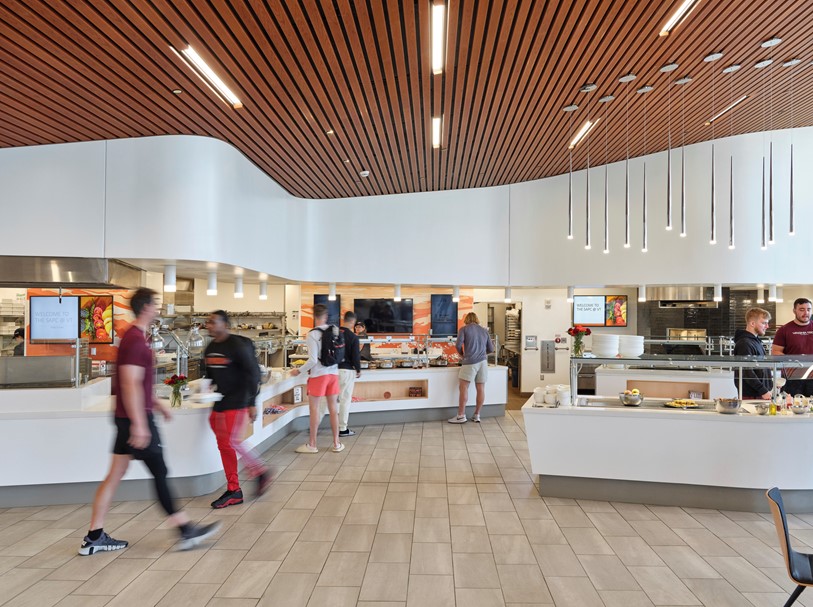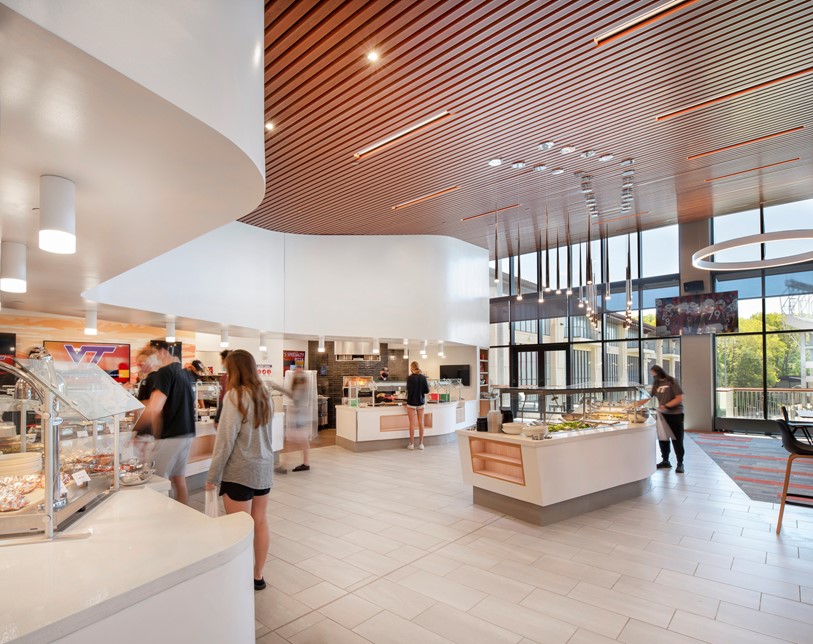Fueling Student Athletes Through Dining Facility Design, Part 2
In the second of this two-part series on innovation in the design of student athlete performance centers, Keith Storms, Rob Reis, and Matthew Lee delve deeper into some of the biggest lessons in creating supportive environments for student athletes, coaches, and staff. This includes specific considerations for creating more calming spaces for student athletes, finding more subtle forms of environmental branding, and integrating programming and design.
There is growing acknowledgment among college and university student athletics departments of the need to invest in more supportive architectural environments that better meet student needs – both physically and mentally.
Virginia Tech’s Student Athletic Performance Center (SAPC) has integrated best practices and insights from across building types – including residential, academia, civic and cultural, and healthcare – and applied them to design a new model for student athletic facilities
This includes design considerations that enhance the well-being of the students and staff that gather, study, and relax in these facilities.
Creating a calming and relaxing environment for student athletes
There is growing evidence of the direct link between our physical environment and our stress level. SAPC brings in knowledge and best practices from across Hanbury’s portfolio in using design moves to create spaces that feel warm, calming, and relaxing. Well-designed space can provide a respite – rather than an additional stressor – to the demands students are balancing and gives students a moment to pause during their day, both during and outside of mealtimes to do work or catch up with friends.
These design considerations include:
- Natural light: The design of the SAPC provides ample daylighting and filtered natural light with glare and direct-sun control rather than relying on fluorescent overhead lighting
- Coherence and legibility: Clear and legible layout and circulation planning thoughtfully organize activity in the space and prevent crowding
- Sound: A linear perforated metal ceiling system with sound absorptive panels above brings warmth and acoustic dampening to the space
- Natural imagery and materials - ‘experiential graphics’ - and expansive views: Natural imagery and materials are woven into the design. Murals depict images from a hike along the Blue Ridge Mountains looking back over the valley toward campus. The stylized graphics are rendered using an array of the University’s branded colors and line the walls in food prep areas visible to patrons
FSC Certified, sustainably sourced wood and other natural materials are integrated for durability, warmth, and beauty
- Restorative zones: SAPC is accessible to students between meals and after hours and is flexible enough to allow students to use it in a variety of ways, including for focused study and reflection. An array of dining balconies with expansive views of Lane Stadium gives students an opportunity to step out for a breath of fresh air. As Alyson Onyon, Senior Director of Sports Nutrition at Virginia Tech reflects on the new space, “It’s created an inviting atmosphere that’s not chaotic and is calming. Student athletes will often stay for a couple of hours even if they are done eating and can enjoy good food but also be able to converse and hang out with other athletes from different teams”.
 Branding can be subtle rather than heavy-handed
Branding can be subtle rather than heavy-handed
Leadership at Virginia Tech has realized that successful, happy, and supported students are the ultimate recruitment tool and have emphasized designing a space that focuses on them and their well-being.
There is often a tendency toward heavy-handed and overt university environmental branding and graphics. The approach seen across many universities is focused solely on school colors in banners, hardscape, and plastic decor (much of which is environmentally unfriendly and composed of materials containing toxic chemicals).
SAPC opts for subtler integration of Virginia Tech’s signature colors, with inspiring imagery that highlights the spirit and values of the Virginia Tech Athletics community, creating memorable moments they want to capture and share, and letting the views of the stadium and facilities speak for themselves.
SAPC uses quotes and imagery reflecting the values, achievements, beliefs, and role that athletics plays in Virginia Tech student life, conveying a rich past, vibrant present, and promising future. Environmental graphics more directly connect with the mission and vision of Virginia Tech Athletics in a way that feels timeless and beautiful. Subtler nods like flecks of orange in the carpet and orange-hued ceiling panels reference university tradition and identity without domineering the design.
The most photographed element of the SAPC is The Connector, a transformed link between the Cassell Coliseum concourse and the SAPC. The Connector has reached iconic status, with ethereal backlit walls and ceiling, perforated with quotes and statements reflecting the ethos and values of VT athletics, it was the backdrop for the recent new football uniform reveal. The Connector opens into the SAPC framing views of the practice field and Lane Stadium beyond. The Jamerson cross corridor features folded graphic panels depicting not only VT teams, individuals and moments, but also athletes as students, connecting them to the student body, the university, and the community.
Integrating design and nutrition programming
SAPC integrates design strategies that support the innovative nutritional programming offered by the department’s nutrition team, made up of six registered dieticians.
The innovative kitchen embraces a 'demonstration style' cooking approach where entrées are prepared fresh, on demand, as the customer waits. In this manner, the 'kitchen' is de-centralized across the servery counters and the preparation process more direct and simplified, with a variety of distinct menu offerings.
The facility embraces sustainability processes and messaging through tabling events and comprehensible nutritional information throughout, while also using a biodgester to address food and service waste. SAPC also integrates nutritional information and counseling, and there are plans to expand nutrition education.
Virginia Tech’s SAPC provides a useful model and adaptable design strategies in a promising movement to create supportive, integrative spaces for America’s student athletes.



